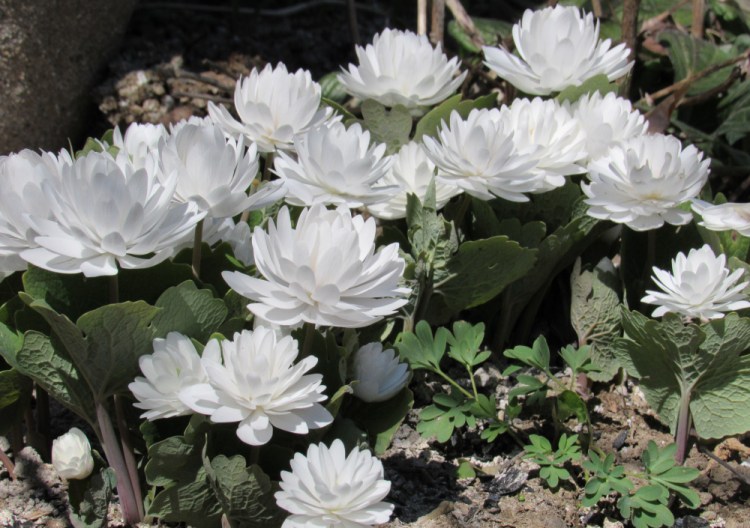People often talk about shade gardens as if they are a specialty. For most gardeners, though, if you have an ornamental garden, at least part of it will be a shade garden.
In my wife Nancy’s and my garden, only two areas have full sun: the center of the vegetable garden and a small area next to the road. Most of our plants have to tolerate, if not prefer, shade.
The reason for all the shade is that gardeners like their trees.
“The trees have to be looked on as the biggest plant in your garden,” said Rick Sawyer, who with his wife, Denise, owns and runs Fernwood Nursery and Gardens, which bills itself as “Maine’s shadiest nursery.” “In very dry periods, the water goes to them before the other plants, and they get all the light.”
Shade plants often are the native plants you notice when you take a walk in the woods, and those natives are the ones Sawyer first learned to love. They include ferns, bloodroot, hepatica and wild orchids like lady slippers and trillium.
“These are plants that are sort of not in your face,” Sawyer said. “You have to get down on hands and knees and really pay attention to what it has to offer as a horticultural wonder.”
It is not just the flowers that draw his attention, but also the structure of the plant when it is not in bloom.
While the plants Sawyer mentioned as favorites are natives, Fernwood, located in Montville just inland from Belfast, also sells many imports that will grow in the same conditions, most of which are propagated on their own property.
They grow a lot of hostas, the first plant many people think of for shade gardens. Hostas have big leaves that draw the eye with their deep textures and varied colors, and many have attractive blossoms. They are a favorite food for deer, but can be protected with fences and various deer-repellent sprays.
After talking with Sawyer, I took a walk around our yard to assess some of the shade plants with which we have success – and we have lots of them.
I’ll start with shrubs.
Azaleas and rhododendrons thrive in shade, and by choosing your varieties well you can have blossoms from early April through late July. Viburnums are another winner, with white blossoms in May and June and berries on some varieties from late summer through the winter. Hollies have white flowers in late spring, while their red berries brighten the winter – and many Christmas decorations. While yews thrive in dense shade, a prettier evergreen is the native hemlock. The tree grows 90 feet tall, but some smaller versions are just 15 feet tall and may have white tips or golden needles.
People keep pushing hydrangeas so much that I am getting bored with them, but the arborescens such as “Annabelle” and some macrophyllas produce stunning blossoms in dense shade, and they last from July until you cut the dried blossoms off the following spring.
Some of my favorite perennials are shade lovers. Rodgersia has huge pink to white blossoms, but the plant’s prime attribute is its foliage, which is deeply textured and changes colors from green to bronze with tinges of pink, depending on the variety.
Peonies are wonderful, but they are mostly sun lovers. The Japanese woodland peony, as its name implies, grows underneath trees and blooms about a month earlier than other peonies – although the blooms go by way too quickly.
Solomon’s seal – both the shorter variegated version and plain green taller one – are architectural statements in the garden. Our aruncus produces a cloud of creamy white blossoms in the corner of our lot while fighting off the roots from the Norway maples on one neighbor’s property and a huge hemlock on the other neighbor’s land. Bleeding hearts thrive in shade, but we aren’t fans, so we don’t grow them.
We have both the truly perennial foxglove, which is yellow and we know where it will come up each year, and the biennials, which move around because they seed themselves. (Biennials produce greenery in their first year, flowers and seeds in their second and then die.) Daylilies produce brighter, bigger blossoms in full sun but do flower in quite a bit of shade, too, although they get lankier.
Ferns are considered a shade-loving plant, but Sawyer said that, depending on the variety, they will grow anywhere – full sun, dense shade, boggy soil and dry soil. Although they don’t flower, they do come in many colors and create a sea of color when a breeze blows through them.
Lily of the valley is the standard shade-loving groundcover, and its fragrance is strong and sweet. Vinca also works well. Some less-used but strong groundcovers are Canada mayflower and sweet woodruff, which is dainty with a small white bloom and with the added benefit of being an ingredient in May wine.
I’m sure I have omitted many excellent shade plants – leaning as I always do to the ones I like. But I have heard too many people over the years say that they can’t grow a garden because they have too much shade.
You now know there is never too much shade to prevent your creating a beautiful garden.
Tom Atwell has been writing the Maine Gardener column since 2004. He is a freelance writer gardening in Cape Elizabeth and can be contacted at 767-2297 or at: tomatwell@me.com
Send questions/comments to the editors.


